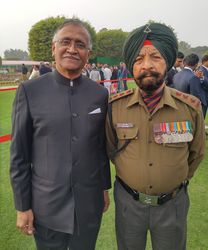Pervez Musharraf died last week, unmourned in India save by Shashi Tharoor. Tharoor’s tweet extolling Musharraf’s peace bids is being trolled by BJP diehards. They forget that it was Atalji Vajpayee who taught the commando-general the value of peace.
Come to think of it, three Indians taught him to seek peace. Vajpayee was the last, the second a four-star general, and the first a poor naib-subedar.
Musharraf, as we all know, was an India-born mohajir, an outsider in the Pakistani elite circles where the zamindar’s brother-in-law is the MP, the MP’s cousin owns the district’s biggest factory, the factory-owner’s nephew is the major-general, the major-general’s wife is the minister’s sister, the minister’s nephew is the police chief, the police chief married the cabinet secretary’s daughter, the cabinet secretary’s aunt married the ambassador, the ambassador’s brother is the zamindar we started with, the zamindar’s grandson has just picked up a lieutenant-colonel rank and is eyeing an attache post in Paris or London. Power, privilege and pelf in Pakistan revolve around 200 families, most of them Punjabis, a few Sindhis and fewer Pathans.
A first-gen army officer, Pervez did not belong to any of these, yet he rose to the star ranks dominated by Pathans like Ayub and Yahya Khan and Punjabis like Zia-ul-Haq. The guy looked hardly military; on the street in shirt-and-trousers, as we saw him in 2001 visiting his nativity spot in Delhi’s Nehrwali haveli, you would have mistaken him for a bank manager or a middle-level mandarin.
We all know how Vajpayee brought down the general-turned president who came to Agra surrounding himself with hubris. The guy talked Kashmir, Kashmir and Kashmir while Vajpayee and Co had many issues to chat about including terror. To cut a long summer day’s talks short, the summit collapsed and a livid Musharraf took a midnight flight to Islamabad. Soon he went to hunt with George Bush and run with the Taliban in Afghanistan, but was peeved when Bush let the Russia- and India-beholden Northern Alliance to capture Kabul. Finally, he vowed before Vajpayee that he would not let the land under his boots to be used for launching terror against India.
His earlier encounter with India was when he sent troops from his force command northern areas, disguised as mujahideen, to capture the Kargil hilltops and direct howitzer fire to disrupt Indian supplies to Ladakh.
Gen. Ved Malik sent troops up the craggy hills, and knocked them out with some help from air chief A.Y. Tipnis’s fighters and copters. The defeat convinced Musharraf of the Churchillian dictum, to jaw-jaw is better than to war-war.
But the man who drew first blood with him—so to speak—is a little known sardar, then a poor naib-subedar. Back in 1987, troops led by Major Varinder Singh made three bids to capture Quaid Post, the highest point on the Saltoro Ridge from where troops commanded by Musharraf, then a brigadier, were threatening western Siachen. A fourth bid, led by Naib Subedar Bana Singh, knocked out the Pakistanis, and captured the peak. The post, since then in Indian hands, is still known as Bana Post, and the operation as Op Rajiv. Not after the then PM, but after Second Lieutenant Rajiv Pande, who had been killed in an earlier bid.
Bana lived to tell his tale. Those who watched the R-Day parade this year too would have spotted him wearing his Param Vir Chakra, and standing proudly in a parade jeep. I spotted him again that afternoon at the President’s At Home, had a brief chat and, of course, a snap.
prasannan@theweek.in


